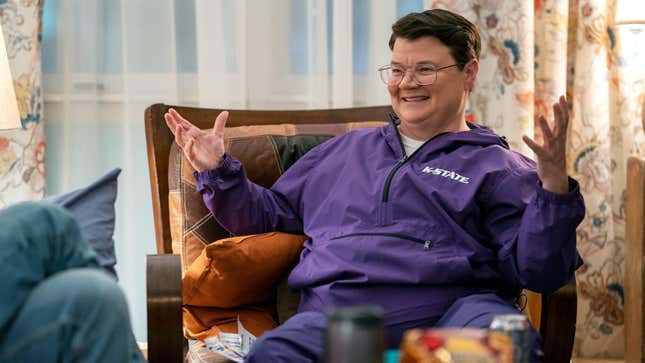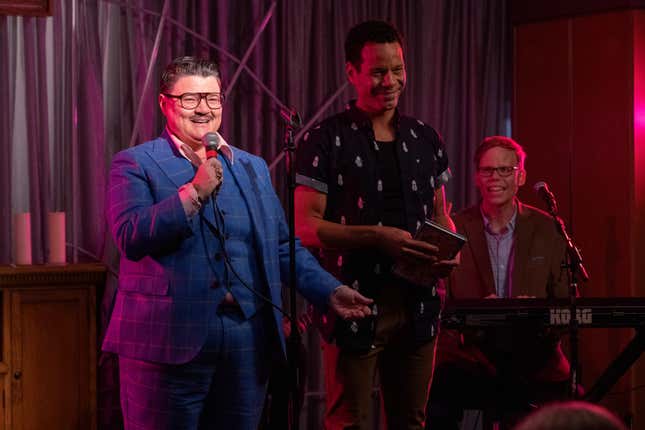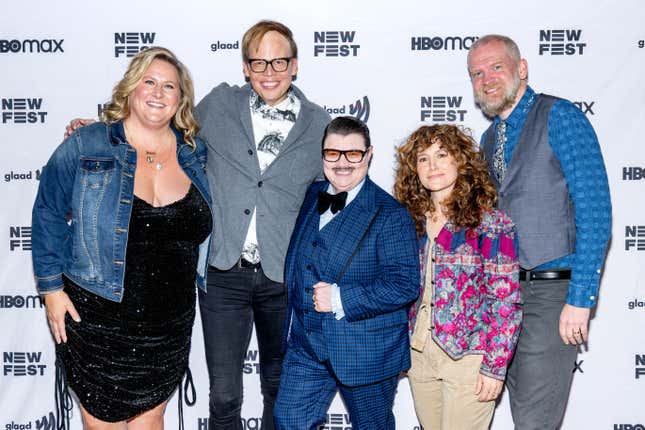The Joy of Watching a Transmasculine Character Who’s Right at Home in Rural America
Among a stellar cast in HBO's Somebody Somewhere, Fred Rococo is quietly radical, wonderfully nuanced representation.
In DepthIn Depth
Image: Sandy Morris/HBO
Somebody Somewhere is set in the rural town of Manhattan, Kansas, and follows Sam (Bridget Everett), a 40-something who’s struggling to find a sense of purpose in her hometown while mourning her sister’s death. Imbued as it is with gravitas and humor, introspection and self-effacement, the camp and the mundane, the show lands “somewhere” (pun intended?) between drama and comedy. Just watch it—Season 2 premiered Sunday on HBO—and you’ll see how the showrunners and cast create that “realness” everyone is talking about.
And while Somebody Somewhere is about feeling lost, it doesn’t pin much blame on rural Kansas. Unlike The Wizard of Oz, there is no hopeful tornado to take Sam away from the place she grew up (though there is a very literal tornado). Nor is Sam arriving to this sleepy little town from the big city, thus armed with the worldly perspective one garners from a concrete jungle. Instead, she stays close to home and finds her chosen family in a crew of local misfits, many of whom are queer. That crew includes Fred Rococo, played with an indelible mix of humor, sensitivity, and tenderness by New York City nightlife performer Murray Hill.
“I think Fred and I share the same spirit and wink and twinkle in the eye,” Hill told Jezebel. “The difference…well, Fred is an agricultural professor and I’ve got a PhD in showbiz.” Or, as Everett described to Jezebel, “Fred is the more rural, stripped-down version of Murray. Still lovable, still funny, but more interested in grain reports than zingers.”

By night, Fred is the master of ceremonies for a secret gathering, covertly referred to as “church” by Sam’s newfound crew. We first encounter him behind a podium at the head of the tabernacle, wearing a baby blue suit, aviator glasses, and gold rings. In a leisurely manner—the kind you reserve for people you know, for your neighbors—he welcomes a modest crowd for the evening’s variety show (a toned-down version of Hill’s larger-than-life gigs in New York). But by day, Fred is a soil scientist at the local university, and this is the Fred we meet in Episode 2 of the first season when he joins Sam, Joel (Jeff Hiller), and Michael (Jon Hudson Odom) out to brunch. It’s a family-style place with no frills, the kind of locale many of us have memories of frequenting: fidgeting in a high seat next to our parents, going on our first date, nursing a hangover with our college roommate. Here, Fred wears a gray tee with a purple hoodie, and a black baseball cap with a purple brim. He makes easy chat with Sam, gently corrects a server who misgenders him, and good-naturedly joshes his mates for racking up high bills after he offered to pay.
Why detail these scenes? They aren’t overtly dramatic—which is par for the course for Somebody Somewhere. They don’t establish life or death stakes for a queer character at odds with their community or open a window into the suffering one experiences from being different. Nor do they depict a glamorous 20-something figuring life out against an exotic backdrop. And that’s precisely the point.
Fred is a person at ease in his surroundings. Like Hill says, he’s “the guy who lives next door, but it’s a few blocks away.” He’s a presence but not a spectacle. In short, the rural town of Manhattan, Kansas, is his home. Set within the history of transmasculine representation, this normalness, this everyday character, is pretty radical.
Transmasculine Representation in Film and TV
For decades, transmasculine and masc-of-center nonbinary representation in film and television was sparse, and when it did exist, tended to reflect damaging misconceptions about the community. The 2020 Netflix documentary Disclosure traces the earliest film allusions to transmasculinity back to D.W. Griffith’s Judith of Bethulia (1914)—yes, the same D.W. Griffith who made The Birth of a Nation, “the most reprehensibly racist film in Hollywood history.” Not surprisingly, the depiction was derogatory.
Before the 2010s, hit movies like Yentl, Victor/Victoria, and She’s the Man served as a fulcrum for allowing transmasc viewers to imagine living openly: in school, at work, or as a sensation on the stage. But these stories ultimately undermined that very dream. After all, a woman dressed as a man for a purpose—for protection, to get a job, to go school—not because it was his identity. As such, there was always a redemption scene, when she shucked off her male attire and reverted to her feminine form (sigh of relief). And the male protagonist who was in love with the “boy” was saved from the crisis of being a homosexual because the object of his affection was a girl (second sigh of relief).
-

-

-

-

-

-

-

-

-

-

-

-

-

-

-

-

-

-

-

-

-

-

-

-

-

-

-

-

-

-

-

-

-

-

-

-

-

-

-

-










































